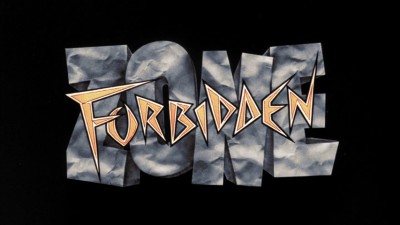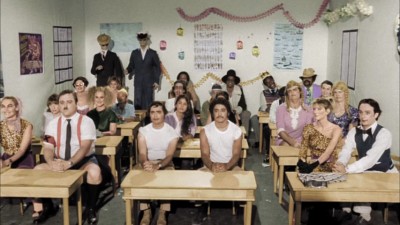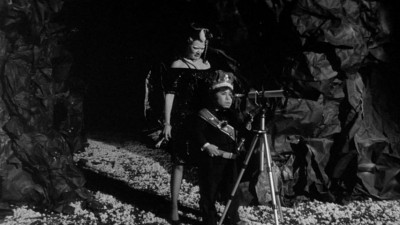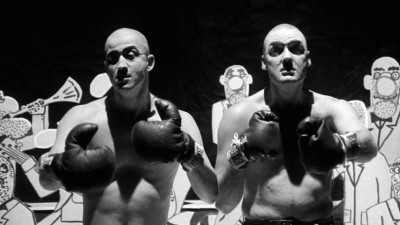| Reviews & Columns |
|
Reviews DVD TV on DVD Blu-ray 4K UHD International DVDs In Theaters Reviews by Studio Video Games Features Collector Series DVDs Easter Egg Database Interviews DVD Talk Radio Feature Articles Columns Anime Talk DVD Savant Horror DVDs The M.O.D. Squad Art House HD Talk Silent DVD
|
DVD Talk Forum |
|
|
| Resources |
|
DVD Price Search Customer Service #'s RCE Info Links |
|
Columns
|
|
|
Forbidden Zone
Art film: the motion picture
 Reviewer's Bias*
Reviewer's Bias*
Loves: John Waters films, "Dead Man's Party", cult films
Likes: Oingo Boingo, Danny Elfman
Dislikes: The Kipper Kids
Hates: Weird for weird's sake
The Story So Far...
A lesser-known cult favorite, Forbidden Zone has had a relatively frequent publishing schedule on home video, getting a DVD release in black and white in 2004 from Fantoma Films, followed by a color version put out by Legend Films in 2008. There was also an ultimate edition on Blu-ray in 2015, which included a CD soundtrack. All three have been reviewed by DVDTalk.
The Movie
Somehow, until this DVD crossed my path, I had never seen Forbidden Zone, a delirious mix of John Waters and old-school pre-PC cartoons courtesy of film composer Danny Elfman's older brother Richard. That shouldn't be a big surprise, as it's not exactly a well-known film, but for someone who seeks out the fringe of film, it's rare to find something that's personally new and undiscovered. Now that I have, it's a pleasure to say the wait was worth it, as this film is the kind of over-the-top experience so rarely seen in film today.
When a film opens with text talking about a pimp named Huckleberry, and Huckleberry is a guy in hardcore blackface, you know you're in for it, and that's the case here, as we learn that Huckleberry's house contains a portal to the Sixth Dimension, which becomes the Hercules family's problem when they move in. A motley crew, the family is a bunch of nuts, outside of Frenchy (Marie-Pascale Elfman), the daughter who inexplicably speaks with a French accent. Soon enough, in an Alice in Wonderland sort of way, she's pulled into the Sixth Dimension, where she meets bizarre denizens like the small French king (Herve Villechaize), his giant queen (Susan Tyrrell), a pair of jockstrap-clad goons (the Kipper Kids), a frog-headed butler and a topless princess (Gisele Lindley). Suffice it to say, the film is weird.

Back on Earth, things aren't much more normal. Besides the Hercules family, the school Frenchy attends is full of unusual folk, including her cross-dressing teacher, a Hitler lookalike, a gaggle of jive fellows and Chicken-boy (Matthew Bright) a strange youngster from a broken family, who could easily be a Fred Armisen character. If you can't deal with random stuff like this, this is not the movie for you. There are several points that are simply haunting, including a chubby boy in Mickey Mouse ears who gets the Clutch Cargo treatment during a twisted Latin musical number (a visual that will stay with you forever.) Musical numbers like this, which repurpose older music from performers like Cab Calloway and Josephine Baker, make for an even more unique and idiosyncratic tone, and are a big part of the film's appeal. In another reality, there are even more songs, and people dress up like Villechaize and Tyrell for midnight screenings of Forbidden Zone.
The creativity in this movie is off-the-charts, with a look and feel that feels right at home with the great cartoons of the 1930s, while providing gorgeous animation to match. The influence of Monty Python and silent film seems to be found throughout as well, making for a fascinating blend of style and concepts, which only gets better when Danny Elfman's music is laid over it (especially when it's him that's singing said music while appearing as a white suit-wearing Satan.) Is there a story to go with all this madness? Maybe. But to be honest, the plot escapes me and I couldn't care less. Forbidden Zone is more about feel than anything else. How it makes you feel. And it should make your brain feel good. Good and weird.
It's worth pointing out that the film is presented in both its original black and white scheme and a later computer colorization. Watching them both, the black and white is a more natural fit for the film's look, but the color adds a whole other level of style to the proceedings. Though the original is the preferred version, there's nothing wrong with the newer edition--it's just different.

The DVDs
Forbidden Zone arrives on a pair of DVDs, which are held in a standard-width dual-hubbed keepcase. Each disc has a slightly different animated, anamorphic widescreen menu offering options to play the film, select scenes, adjust the setup and check out the extras. Audio options vary, with the color version of the film offering 5.1 Dolby Digital, 5.1 DTS and 2.0 Dolby Digital English tracks, while the black and white version has 5.1 and 1.0 Dolby Digital mixes. There are no subtitles and no closed captioning.
The Quality
Whichever version you watch, the anamorphic widescreen transfer looks terrific, especially when you consider the film's age, budget and pedigree. Though the film feels more correct in black and white (considering the set design and elements of old-time film), the color looks impressive, with a soft saturation that feels right for colorized film (which it is.) The intertitles in color are so crisp they look like they were made yesterday, while the animation has a crisp, yet handmade feel to it. There are some minor spots of dirt and damage in both editions, but you have to look for them, in images that are nicely detailed and only occasionally soft, with no noteable compression issues. Popping this in, you wouldn't expect this film to look this good.
You've got lots of options when it comes to the sound here, including the steady authenticity of the mono track, but to get the best experience, the DTS 5.1 surround should be your choice. Music is strong and crisp, while dialogue is delivered without distortion, with most of the sound living in the front of the room. The surrounds offer a bit of pop though here and there thanks to some panning and discrete placement that tie in nicely with the on-screen action. This isn't an aural blow-out, but between the Elfman music and neat effects, it's a fun track.
The Extras
The extras for Forbidden Zone are all culled from the previous releases in 2004 and 2008, and are spread across the two discs, starting with a 3:46 intro from Richard Elfman. As one might expect, it's off-kilter, as Elfman, clad in underwear, a cape and a fez, offers some info on the film and talks about the hope for a sequel (with some concept art.) Considering it's been at least eight years since this was shot, odds look slim. CORRECTION: This footage was actually only shot a few months ago, specifically for this release, and Forbidden Zone 2 is close to a starting date. So, hope lives!
A feature-length commentary with Richard Elfman and Bright is an enjoyable experience that fits with the film, as the two friends reminisce about making the film and the origins of the Mystics Knights and share various anecdotes. Bright is a bit loose cannon, talking about how he wishes he had sex with a co-star (with less genteel language) and noting which castmates are now dead, but he makes it an entertaining listen.
"A Look Into Forbidden Zone" (37:15) is a nicely extensive history of the film, with the surviving main cast taking part in interviews with Richard Elfman and covering all the bases over the course of the piece, including the animation, music, casting and more. For Oingo Boingo fans, Danny Elfman's participation is the key draw, as are the clips from the Mystic Knights' stage shows, which illustrate where the film's style was born.
More Richard Elfman weirdness can be found in the self-explanatory "Richard Elfman Beats Danny Elfman's Forbidden Zone Theme" (2:17) in which the once-again Fez-wearing Efman pounds out the film's iconic theme song on conga drums while a buxom woman in an afro wig and sequined hot pants dances. So...yeah. There's also a "Japan Promo" in which Elfman offers some history and an intro to the film.
It's not quite clear what "Scenes from The Hercules Family" might be, but apparently it was a work that preceded Forbidden Zone's lead clan. It's presented without context (and without sound outside of some scratchy noise) so it will remain just an oddity, sort of like the 11:18 of Outtakes that follow, which delivers more of the creepy Kipper Kids, as well as a flash of Frenchy's breast, for those looking for it. Four deleted scenes (4:47) have more structure to them, but they are just as nonsensical as the rest of these clips.
If you're watching the black and white version of the film, you can enjoy the wonderful Danny Elfman music as it stands by itself in a music-only track, which is a nice treat, along with the very ‘80s trailer (:47). What's less of a treat was the missing booklet, an issue the publisher has apparently fixed since its release. Also not here are the pop-up trivia track from the 2008 release and whatever "The Passion of Squeezeit" is.
 The Bottom Line
The Bottom Line
Forbidden Zone is a nutty bit of madness--a glorious mix of art-school creativity and cartoon aesthetics--that will entertain the open-minded and disturb the norms. It's unhinged and barely coherent, but it's compulsively watchable. This package, which gathers much, but not all of the previously released bonus content, along with both versions of the film, looks and sounds quite nice and is offered at an affordable price that reduces the barrier to taking a chance and picking it up. If you like it weird, you'll like this film. Forbidden Zone would easily get a rating of highly recommended, but it's too polarizing a film for mass audiences.
Francis Rizzo III is a native Long Islander, where he works in academia. In his spare time, he enjoys watching hockey, writing and spending time with his wife, daughter and puppy.Follow him on Twitter
*The Reviewer's Bias section is an attempt to help readers use the review to its best effect. By knowing where the reviewer's biases lie on the film's subject matter, one can read the review with the right mindset.
|
| Popular Reviews |
| Sponsored Links |
|
|
| Sponsored Links |
|
|
| Release List | Reviews | Shop | Newsletter | Forum | DVD Giveaways | Blu-Ray | Advertise |
|
Copyright 2024 DVDTalk.com All Rights Reserved. Legal Info, Privacy Policy, Terms of Use,
Manage Preferences,
Your Privacy Choices | |||||||













